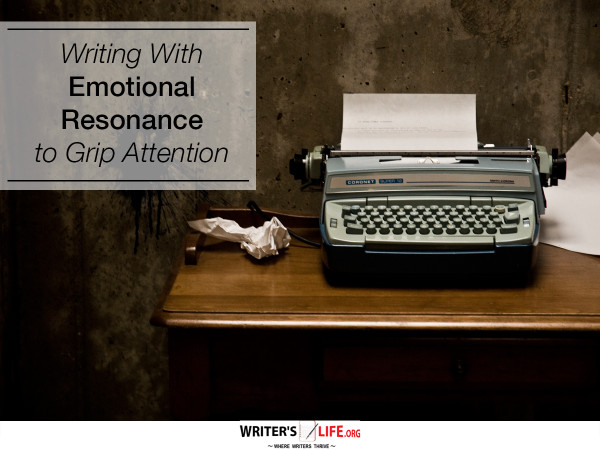- How To Tackle Jealousy In Creative Writing
- Common Submission Mistakes
- How To Stop Your Blog Becoming Boring
- The One Thing Every Successful Writer Has In Common
- How To Make Yourself Aware Of Publishing Scams
- Why Almost ALL Writers Make These Grammar Mistakes At Some Point
- 5 Tips For Authors On How To Deal With Rejection
- Top Mistakes to Avoid When Writing a Novel
- How to Avoid Common New Writer Mistakes
- 10 Mistakes New Fiction Writers Make
Writing With Emotional Resonance to Grip Attention

Share, Pin or Retweet This is You Love Writing!
There is nothing to writing. All you do is sit down at a typewriter and bleed. ~ Hemingway.
Naked emotions?
Like I felt when I finally gave up screaming for help.
When I sank to my knees and wept by the side of the stream, watching my horse about to drown–and unable to rescue her.
I’ll tell you what happened in a moment …
But this post is not about the horse and not about myself.
It’s about letting naked emotions bleed through your writing.
Emotions connect us with each other. In fact, research shows that specific cells in the brain create a virtual reality which connects us directly with the emotions of others.
More about that later.
This post will show you how to write better by harnessing the power of naked emotions to connect deeply with your readers.
But first, let me tell you about the horse.
Here’s what happened …
One hot afternoon, deep in the Columbian countryside, I asked the owner of an estancia whether I could take one of his horses for a ride. He nodded and I soon sat astride a pretty bay mare called Alesia.
I tend to think of myself as a ‘confident rider.’ The reality is that I feel confident about riding, but I’m actually inept on a horse. It was this clash of perception versus reality which led to the nightmare.
Problems showed up as soon as I headed out across the vast, sunbaked plain.
When I tried to make the mare go faster, she slowed down. And when I wanted her to slow down, she sped up.
At last I got her to canter and, as we approached a stream, I kicked her flanks to make her jump down the bank and gallop through the stream.
But Alesia reared up, refusing to go ahead. Frustrated, I gave her a flick with a stick.
She then plunged forward–and jarred to a halt in the middle of the stream. I had to grab the saddle to stop falling off.
And then I noticed.
Alesia was sinking.
The more she struggled, the deeper she sank.
I tried to make her go forward, or turn around. But she couldn’t move.
Quicksand!
When the mud crept up her belly, I realized we were both in danger.
So I slid off her rump–and immediately got sucked down myself.
I thought, ‘Is this the end? Am I going to die here?’
Then I remembered reading that when you’re stuck in quicksand, you need to use delicate swimming movements to propel yourself forward and upward. I tried, and–little by little–got closer to the bank.
Finally, I could feel firm ground under my feet and lunged onto the grassy verge.
I trembled all over.
Then I looked back.
Alesia was now up to her shoulders in mud–and still sinking.
Her nostrils flared and her eyes rolled.
I ran back and forth, swore, shouted, screamed.
But nobody heard me.
Finally, I sank to my knees and wept.
Now only Alesia’s head rose above the muddy water. Her eyes seemed to implore me for help.
But I didn’t know what to do.
And then, just as she was about to drown, something unexpected happened…
I’ll continue the story in a moment.
But first, I’d like you to check in with your emotions.
What do you feel right now?
Do you feel a tinge of the panic and dread I felt when my horse and I were caught in the quicksand?
If so, you’ve just experience the viral nature of emotions.
The reason you can feel the emotions of others is because of mirror neurons in the brain.
How the brain’s virtual reality affects us
Let me ask you something.
Do you flinch when you see someone burn their fingers on the stove? I bet you do!
That’s your mirror neurons in action. These neurons perform a virtual reality simulation of what you’re observing. That’s how we can experience the emotions of others.
When someone cries, we feel sad. When someone yawns, we tend to yawn too.
But what about writing?
It’s simple: mirror neurons are triggered not only by what we see or hear; they are also triggered by what we read.
Our mirror neurons are fired up by the writer’s emotions.
When we write and let naked emotions flow onto the page, our readers resonate with us. This process is called emotional resonance.
There are three secrets you need to know in order to fire up the mirror neurons in your readers.
Read on to find out what they are.
The 3 Secrets of Harnessing Emotional Resonance
The first secret may seem self-evident, but writers often overlook it: you must yourself feel the emotions you write about.
Secret #1: Feel, feel, feel
Feel, he told himself, feel, feel, feel. Even if what you feel is pain, only let yourself feel. ~ P.D. James, The Children of Men
If you want to convey an emotion, you must feel it as you write.
You can’t just sit down cold and hope your writing will warm up your readers.
If it’s a personal story, close your eyes and remember what the experience was like. Remember the physical sensations. Recall what you saw, heard, and smelled.
If you’re writing fiction, you need to imagine the scene with all its sensory details and emotions.
Only then write your story.
Like this one by Jon Morrow, called How to Be Unforgettable:
I’m lying in bed in a nursing home, sick and dying, gasping for breath, knowing that any minute now I’ll be passing into the great beyond.
The story is gripping and you can feel his terror in your own gut as you read the story. Then Jon says:
Scary, isn’t it? Just writing it down gives me the willies.
And there you have it! Jon felt the emotions as he was writing the piece. That’s why it’s so powerful.
But what carries emotion?
Stories! And that brings us to the second secret.
Secret #2: Give your readers the stories they crave
After nourishment, shelter and companionship, stories are the thing we need most in the world. ~ Philip Pullman
You and I, along with all other human beings, communicate with stories. Ask anyone about their new hairstyle, their girlfriend, their kitten, or their broken computer–and you’ll get a story in return.
Stories are the universal language of mankind.
That’s why stories are a great way to bond with your readers and illustrate a point. Take the post by Judy Lee Dunn about online identity. Here’s how she starts off:
Sometimes a Google Alerts comes in that wakes you up. Like last Wednesday when I found out I had died. It was kind of weird because I wasn’t really expecting it. Just reading along and, bam. There it was.
What a cool entry to a post about protecting your online identity!
There are three ways you can heighten emotions in a story: foreshadow the incident, change the pace, and craft a setting.
- Foreshadow the emotion
If you foreshadow the emotion you want to transmit, the reader will feel it more keenly.
Here is an example from Donna Tartt’s novel, The Goldfinch.
And there was something festive and happy about the two of us, hurrying up the steps beneath the flimsy candy-striped umbrella, quick quick quick, for all the world as if we were escaping something terrible instead of running right into it.
In this sentence, Donna Tartt braces the reader for a shocking turn of events and creates a sense of apprehension.
- Regulate the pace
Pace controls the speed at which the reader is pulled through a narrative.
If you want your readers to be touched by suspense or fear, whip up the pace by using short sentences and short paragraphs.
In contrast, if you want your readers to experience a sense of calm and relaxation, ease off the pace with longer sentences.
A successful piece of writing needs both fast-paced sections, as well as calm zones.
It’s like rafting a river. To give your reader a thrill, you need the adrenaline of white water. And in between, you need calm stretches for the reader to kick back and enjoy the scenery.
- Set the scene to heighten the emotional response
If you want to heighten the emotional response, create a setting for your story with dynamic descriptions. Each word of the context needs to evoke emotions.
Here are two examples. The first one is by Lisa Unger from her novel, Beautiful Lies.
I can hear the rain falling outside the burned-out building, its loud, heavy drops smacking on canvas. It’s falling inside too, trickling in through gaping holes in the roof down through floors of rotted wood and broken staircases.
Gives you goosebumps, doesn’t it? Notice how Lisa uses words like burned-out, heavy, gaping, rotted, and broken to create a dynamic description which affects the reader emotionally.
You can also use dynamic descriptions when writing strong blog posts or articles.
Here is an example by Ash Ambirge from her fiery post, You Don’t Need a Job, You Need Guts.
I grew up curling my bangs in a trailer park, using food stamps to buy popsicles, dating boys who milked cows, bringing boom boxes to stone quarries, and thinking tinted car windows were the ultimate sign of prestige.
Ash evokes the hopelessness and misery of her early years. Notice how well her cinematic technique of using emotive flashbacks works!
Part of having the guts to writer is also discipline. If you have a novel it can be an interesting challenge trying to reconcile your creative side with the business side. It is important to stay disciplined and on schedule. That is why The Get It Done, Writer's Toolkit CLICK HERE! is highly recommended for writers of fiction as it helps you stay on track and avoid writer's block and procrastination.
3. Shhhh! Don’t tell
Show the readers everything, tell them nothing. ~ Ernest Hemingway
The emotional resonance is much stronger if you don’t name the emotion.
Why?
Because as soon as you name an emotion, your readers go into thinking mode. And when we think about an emotion, we distance ourselves from the actual experience of feeling it.
That’s why it’s more skillful to show the emotion but not tell the reader about it.
Here is an example from Val McDermid’s novel, The Skeleton Road. She describes how a building inspector with a fear of heights traverses the roof of an abandoned building.
Dry-mouthed, hands slippery inside his work gloves, he crab-walked cautiously down the steep pitch of the slates.
The trick was to keep breathing, slow and steady. That, and not to look down. Never look down.
Down. Christ, even the word made him feel faint this far up.
As you can see, Val McDermid never once uses the word ‘fear.’ But my hands went clammy when I read this passage. Yours too?
Show, don’t tell, also stops you from publishing emotional rants on your blog. On a blog that shall remain nameless, I happened to read: “I was so freaking angry when she broke up with me! She even told me she faked it every time…!”
Yes, well, sorry to hear about the faking. But I don’t think your readers care.
Emotional rants often leave the reader cold because the emotion is named and most often, these kind of posts lack context and setting.
In contrast, stories that the writer feels deeply about–and that illustrate a point–create a bond with readers. They want to know what happened next.
So what happened to the horse?
Just as my horse was about to drown, I heard voices. I jumped up and hollered for help.
Three girls came running. The eldest was about twelve and her siblings were a few years younger.
They immediately sprang into action. The two older ones crossed the stream from the side opposite the horse, feeling their way with care to stay on the stretch part of the riverbed.
They managed to reach the reins and started pulling.
The youngest one took me by the hand and led me across further upstream where the ground was firm.
When I joined the older girls, we all pulled at the horse’s reins.
Finally, the horse managed to get her hooves onto secure ground and burst out of the quicksand with a huge, shuddering squelch.
In tears, I hugged the girls and followed them to their farm. In fact, they walked us right into their backyard pond and carefully washed off the mud. The horse and I were still trembling.
Then I hugged the kids once more, got back onto Alesia and headed home. Very slowly.
We’re on the home straight with this post as well. Let’s take a moment to reflect on the take-away points.
Conclusion
If you want to bond with your readers, you need to make use of emotional resonance. There are three key things to remember:
1. Feel the emotions you want to convey. Only your felt emotions will resonate with readers.
2. Remember to use stories as the carriers of emotions. You can convey feelings, illustrate a point, or reset your reader’s attention by using stories.
3. Show, don’t tell. If you want to use the full power of emotional resonance, don’t name the emotion. Otherwise your readers will start thinking, instead of feeling.
Finally …
It’s your turn.
Think of an emotional experience in your life and consider how you could use it.
Are you writing a novel? Are you interested in self-publishing it? Maybe you would like a about our online Webinar called How to get Published, Sell Books & Attract Tens of Thousands of Readers by Selling Your Content on Amazon Kindle CLICK HERE!. This is a webinar that teaches authors how to publish books online and sell to Amazon's Kindle Direct Publishing Platform and Market as well as promote and sell their written material online and you will find lots of info about how to format, lay out and illustrate your publications.
This article by Mary Jaksch was originally published as "How to Write Better: 3 Secrets of Transmitting Naked Emotions at http://writetodone.com/how-to-write-better-2/.




















